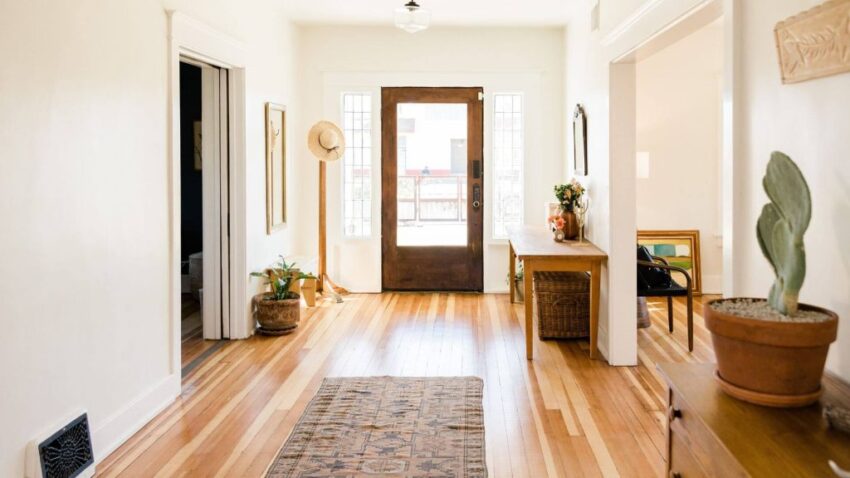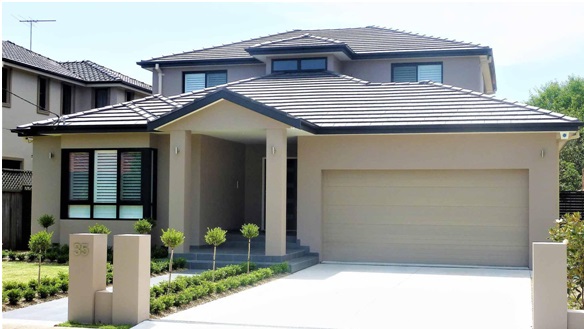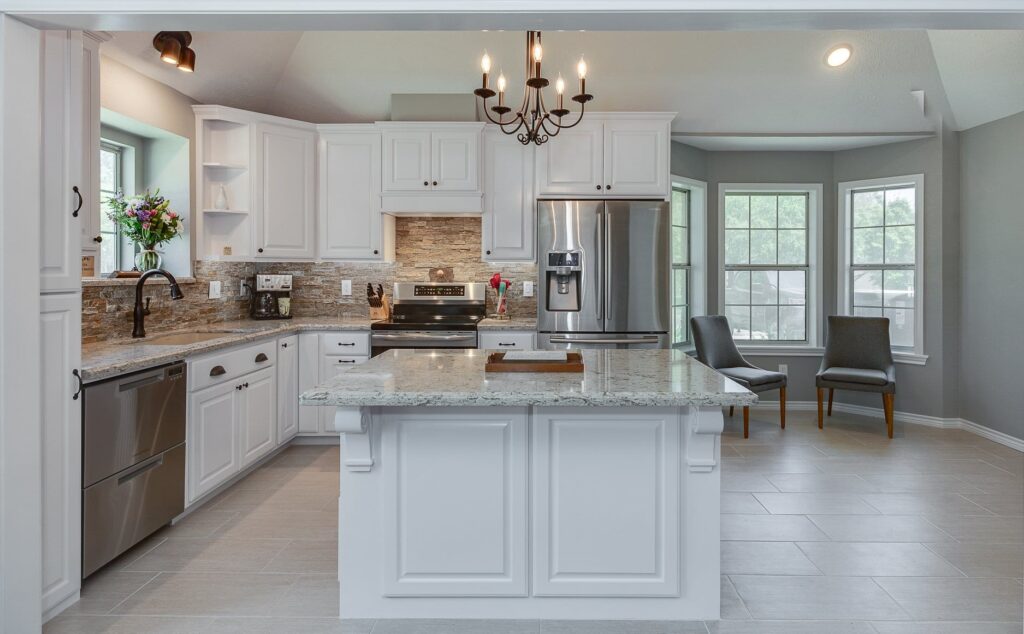When it comes to renovating your home, one of the most crucial decisions you’ll make is selecting the right flooring. Your choice of flooring not only impacts the aesthetics of your space but also its functionality, comfort, and overall value. With so many options available, it can be overwhelming to decide which type is best for your home renovation project. In this article, we’ll explore various flooring options, highlighting their benefits, ideal applications, and maintenance tips to help you make an informed decision.
Hardwood Flooring
Benefits of Hardwood Flooring
Hardwood flooring is a timeless choice that adds warmth and elegance to any home. It’s known for its durability and the ability to be refinished multiple times, which extends its lifespan. Hardwood floors also improve indoor air quality as they don’t trap dust, pollen, or other allergens.
Types of Hardwood: Solid vs. Engineered
There are two main types of hardwood flooring: solid and engineered. Solid hardwood is made from a single piece of wood and can be sanded and refinished several times. Engineered hardwood, on the other hand, consists of multiple layers of wood veneer, making it more stable and less susceptible to changes in humidity and temperature.
Best Rooms for Hardwood Flooring
Hardwood is ideal for living rooms, dining rooms, and bedrooms. However, it’s best to avoid installing it in areas with high moisture, such as bathrooms and basements, unless you choose engineered hardwood.
Maintenance Tips for Hardwood Floors
To maintain hardwood floors, sweep or vacuum regularly to remove dirt and debris. Use a damp mop with a hardwood floor cleaner and avoid excessive water. Place mats at entryways to reduce wear and tear and use furniture pads to prevent scratches.
Laminate Flooring
What is Laminate Flooring?
Laminate flooring is a synthetic product made up of multiple layers that are fused together using a lamination process. It mimics the look of hardwood, stone, or tile at a fraction of the cost.
Pros and Cons of Laminate Flooring
Laminate flooring is affordable, easy to install, and resistant to scratches and stains. However, it’s not as durable as hardwood and can be prone to moisture damage if not properly sealed.
Ideal Areas for Laminate Flooring
Laminate is a great choice for high-traffic areas like living rooms, hallways, and kitchens. It’s not recommended for bathrooms or laundry rooms due to its sensitivity to moisture.
Care and Maintenance
To keep laminate floors in top condition, sweep or vacuum regularly. Clean up spills immediately to prevent damage, and use a damp mop with a laminate floor cleaner. Avoid using excessive water or harsh cleaning agents.
Vinyl Flooring
Understanding Vinyl Flooring
Vinyl flooring is a versatile and durable option available in sheets, tiles, or planks. It’s water-resistant, making it suitable for almost any room in the house.
Types of Vinyl: Sheets, Tiles, and Planks
Vinyl sheets are large, continuous rolls that offer seamless installation. Vinyl tiles and planks resemble traditional tile or wood flooring and are easier to replace if damaged.
Advantages of Vinyl Flooring
Vinyl flooring is affordable, water-resistant, and easy to clean. It’s also softer underfoot compared to wood or tile, providing more comfort.
Best Places to Install Vinyl Flooring
Vinyl is ideal for kitchens, bathrooms, laundry rooms, and basements. Its water resistance makes it perfect for areas prone to moisture.
Maintenance Guidelines
Maintain vinyl flooring by sweeping or vacuuming regularly. Mop with a vinyl floor cleaner and avoid using abrasive tools that could scratch the surface.
Tile Flooring
Overview of Tile Flooring Options
Tile flooring comes in various materials, including ceramic, porcelain, and natural stone. Each type has its unique properties and benefits.
Ceramic vs. Porcelain Tiles
Ceramic tiles are made from clay and are typically glazed for added protection. Porcelain tiles are denser and more durable, making them suitable for high-traffic areas and outdoor use.
Benefits of Tile Flooring
Tile flooring is incredibly durable, water-resistant, and easy to clean. It’s available in a wide range of styles, colors, and patterns, allowing for versatile design options.
Suitable Areas for Tile Installation
Tiles are perfect for kitchens, bathrooms, and entryways. They’re also great for outdoor patios and pool areas.
Maintenance and Cleaning Tips
To maintain tile floors, sweep or vacuum regularly. Clean with a mild detergent and water, and periodically seal grout lines to prevent staining and moisture penetration.
Carpet Flooring
Introduction to Carpet Flooring
Carpet flooring provides warmth, comfort, and sound insulation. It’s available in various textures, colors, and patterns to suit any decor.
Types of Carpet Fibers
Common carpet fibers include nylon, polyester, wool, and olefin. Each fiber type offers different benefits in terms of durability, stain resistance, and softness.
Pros and Cons of Carpet Flooring
Carpet is soft underfoot, reduces noise, and provides insulation. However, it can trap allergens and stains more easily than hard flooring options.
Best Rooms for Carpet Installation
Carpet is ideal for bedrooms, living rooms, and family rooms. It’s not recommended for kitchens, bathrooms, or high-traffic areas due to its susceptibility to stains and wear.
Cleaning and Maintenance
Vacuum carpets regularly to remove dirt and dust. Address spills immediately to prevent stains and consider professional cleaning periodically to maintain its appearance and longevity.
Bamboo Flooring
What is Bamboo Flooring?
Bamboo flooring is made from the fast-growing bamboo plant. It’s an eco-friendly alternative to traditional hardwood flooring.
Benefits of Bamboo Flooring
Bamboo is durable, sustainable, and resistant to moisture and insects. It also offers a unique aesthetic that adds a modern touch to any space.
Ideal Rooms for Bamboo Flooring
Bamboo flooring works well in living rooms, bedrooms, and kitchens. However, it should be avoided in areas with excessive moisture like bathrooms and basements.
Maintenance Tips for Bamboo Floors
To care for bamboo floors, sweep or vacuum regularly. Clean with a damp mop and a bamboo floor cleaner, and avoid using excessive water or harsh chemicals.
Cork Flooring
Understanding Cork Flooring
Cork flooring is made from the bark of the cork oak tree. It’s a renewable resource that provides a comfortable and quiet surface underfoot.
Advantages of Cork Flooring
Cork is naturally insulating, hypoallergenic, and resistant to mold and mildew. It’s also soft and cushioned, making it comfortable to walk on.
Best Places for Cork Flooring
Cork is ideal for bedrooms, living rooms, and home offices. Its softness makes it less suitable for high-traffic areas or wet environments.
Care and Maintenance of Cork Floors
Maintain cork flooring by sweeping or vacuuming regularly. Clean with a damp mop and a mild cleaner, and periodically reseal the surface to protect it from moisture and damage.
Concrete Flooring
Introduction to Concrete Flooring
Concrete flooring offers a modern, industrial look that’s both durable and versatile. It can be stained, polished, or painted to achieve various finishes.
Benefits of Concrete Floors
Concrete is incredibly durable, low-maintenance, and energy-efficient. It also provides a unique aesthetic that can complement contemporary designs.
Best Areas for Concrete Flooring
Concrete is perfect for basements, garages, and outdoor patios. It’s also gaining popularity in modern living spaces like kitchens and living rooms.
Maintenance and Upkeep
To maintain concrete floors, sweep or vacuum regularly. Clean with a pH-neutral cleaner and reseal periodically to protect against stains and wear.
Stone Flooring
Types of Stone Flooring
Stone flooring includes materials like marble, granite, limestone, and slate. Each type offers a unique look and varying levels of durability.
Advantages of Stone Floors
Stone floors are durable, natural, and can add a touch of luxury to any space. They’re also heat-resistant, making them suitable for warm climates.
Best Rooms for Stone Flooring
Stone is ideal for kitchens, bathrooms, and entryways. It’s also a great option for outdoor spaces like patios and pool areas.
Maintenance and Cleaning
To care for stone floors, sweep or vacuum regularly. Use a stone-specific cleaner and avoid acidic or abrasive products that can damage the surface. Periodically reseal the stone to maintain its appearance and protect against stains.
Eco-Friendly Flooring Options
Introduction to Eco-Friendly Flooring
Eco-friendly flooring options are becoming increasingly popular as homeowners look for sustainable and environmentally friendly materials.
Popular Eco-Friendly Materials
Popular eco-friendly flooring materials include bamboo, cork, reclaimed wood, and recycled materials. These options minimize environmental impact and often offer additional benefits like durability and aesthetics.
Benefits of Choosing Sustainable Flooring
Choosing sustainable flooring helps reduce your carbon footprint and supports the use of renewable resources. It can also improve indoor air quality and create a healthier living environment.
Choosing the Right Flooring for Your Lifestyle
Factors to Consider: Durability, Comfort, Aesthetics
When choosing flooring, consider factors like durability, comfort, and aesthetics. Think about how each room is used and the level of foot traffic it receives.
Matching Flooring to Your Home’s Design
Your flooring choice should complement your home’s design and decor. Consider the overall style of your home and choose flooring that enhances its aesthetic appeal.
Budget Considerations
Budget is a significant factor when selecting flooring. Determine your budget early on and explore options within your price range. Remember to factor in installation costs and maintenance requirements.
Installation Tips and Considerations
DIY vs. Professional Installation
Decide whether to tackle the installation yourself or hire a professional. DIY installation can save money but requires skill and time. Professional installation ensures a high-quality finish but comes at a higher cost.
Preparing Your Subfloor
Proper subfloor preparation is crucial for a successful flooring installation. Ensure the subfloor is clean, dry, and level before installing new flooring.
Common Installation Mistakes to Avoid
Avoid common installation mistakes like improper measurements, insufficient acclimation time for materials, and neglecting manufacturer guidelines. Taking the time to do it right will ensure a durable and attractive result.
Maintenance and Longevity
General Maintenance Tips for All Flooring Types
Regardless of the flooring type, regular maintenance is essential. Sweep or vacuum regularly, clean spills promptly, and use appropriate cleaners for each material.
How to Extend the Life of Your Flooring
To extend the life of your flooring, use area rugs and mats to protect high-traffic areas, use furniture pads to prevent scratches, and follow manufacturer maintenance recommendations.
Signs It’s Time to Replace Your Flooring
Signs that it’s time to replace your flooring include visible wear and tear, persistent stains, and damage that can’t be repaired. If your flooring is outdated or no longer suits your needs, it may also be time for an upgrade.
Conclusion
Selecting the best flooring for your home renovation project involves careful consideration of various factors, including durability, comfort, aesthetics, and budget. By understanding the benefits and drawbacks of each flooring type, you can make an informed decision that enhances the beauty and functionality of your home. Whether you choose the timeless appeal of hardwood, the affordability of laminate, the versatility of vinyl, or the luxury of stone, the right flooring can transform your space and add lasting value.
FAQs
What is the most durable flooring option?
The most durable flooring options include stone, tile, and concrete. These materials can withstand heavy traffic and wear, making them ideal for high-traffic areas.
How do I choose the best flooring for my home?
Consider factors like durability, comfort, aesthetics, and budget when choosing flooring. Think about how each room is used and the level of foot traffic it receives.
Is it better to hire a professional for flooring installation?
Hiring a professional ensures a high-quality finish and saves time. However, if you’re experienced and confident, DIY installation can save money.
What are the easiest flooring types to maintain?
Vinyl, laminate, and tile are among the easiest to maintain. They require regular sweeping and mopping and are resistant to stains and scratches.
How can I ensure my flooring choice is eco-friendly?
Choose sustainable materials like bamboo, cork, and reclaimed wood. Look for certifications indicating the use of environmentally friendly practices and materials.




